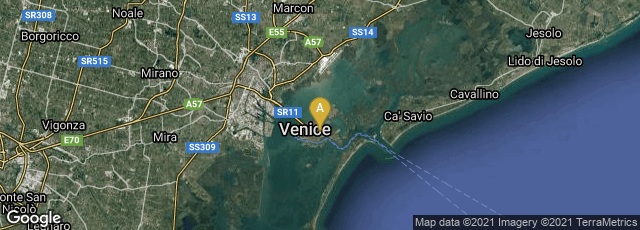

The John Rylands Library copy of the Aldine Virgil, printed on vellum, and illuminated with the coat of arms of the Pisani family of Venice. In the poem on the left page facing Virgil's text Aldus praised the skill of the punchcutter Francesco Griffo of Bologna who designed the new Italic type. This type, based o the Italian humanist cursive script or Cancellersesca originally developed in the 1420s by the humanist and Niccolò de' Niccoli, became the model for later Italic types.
In April 1501 Venetian scholar printer Aldus Manutius issued an edition of the poems of Virgil (Vergil) in Italic type designed by the punchcutter Francesco Griffo, also known as Francesco da Bologna. A very skilled craftsman, Griffo was also a "tumultuous character" who ended his life in the hangman's noose for murdering his son-in-law. This was the first book completely printed in Italic type, an adaptation of humanist script, possibly Aldus's own handwriting. Facing the first page of Virgil's text, Aldus included a poem praising the skill of Griffo who designed the new type. In addition to its elegant design, Italic type had the advantage of a higher character count, allowing more information to be printed legibly in less space than Roman or Gothic type.
Aldus’s edition of Virgil was also the first of a series of volumes that he issued in the pocket, or octavo format. This smaller format had previously been used for editions of devotional texts, but Aldus was the first to use the smaller format to make non-devotional literature available in the more portable format, and at lower cost. Davies pointed out that a signifcant reason for Aldus's introduction of the octavo format was the collapse of the credit market in Venice in 1500 caused by "Venetian defeats and Turkish advances," which caused many business failures, and would have motivated Aldus to publish books that could be sold at lower cost.
"The innovation lay not in the small format, often used by printers for devotional texts, but in applying it to a class of literature hitherto issued in large and imposing folios or quartos. It is also certain that the small-format manuscripts in Bernardo Bembo's library included a good number written by the leading Paduan scribe, Bartolomeo Sanvito, whose hand seems to be the best and closest model for the Aldine italic.
"This famous type was a sympathetic rendering by Francesco Griffo of the best humanist cursive script of the day, a wholly new departure in Latin typography but parallel to Aldus's adaptation of Greek cursive hands for his earlier work. If italic has today become practically confined to words that convention dictates be 'italicized', we must also recognize that it appeared to contemporaries as a revelation of elegance -- to Erasmus, 'the neatest types in the world'. The narrow set of the type is also very economical of paper, an important consideration in those days. The very first appearance is in a few words set in the woodcut that adorns the folio St Catherine . . . , followed by limited use in the preface to the second (quarto) edition of Aldus's Latin grammar of February 1501. Italic reached its manifest destiny as the text type of the book which began Aldus's great series of octavo classics, the Virgil of April 1501" (Martin Davies, Aldus Manutius: Printer and Publisher of Renaissance Venice [1999] 42).
Aldus' pocket editions of Virgil were a commercial success:
".. . . By the time of the dedication to Bembo in 1514, Aldus had already exhausted two editions of the works of Virgil (which we can estimate to have been about 3,000 for each run). By contrast, nearly all the incunable editions of his Greek folios were still available in the third advertisement of 1513, some at reduced prices. Not that the octavos were cheap—Isabella d'Este, the learned Marchioness of Mantua (and another former pupil of Battista Guarino), sent back some vellum copies she had ordered when she was told by her courtiers that they were worth no more than half the price Aldus's partners were asking. These may have been special illuminated copies costing five ducats or more—some exquisite vellum editions that she did buy from Aldus survive in the British Library—but even the plain paper copies, according to Aldus's annotation of the 1503 advertisement, went for a substantial quarter of a ducat" (Davies, op. cit., 46).
"Aldus's great innovation was his production of the libelli portatiles, or 'portable little books,' a phenomenon that is analogous to the paperback revolution of the past half century. He called his creation (later misnamed pocketbooks) the enchiridion, or 'handbook,' meaning a book that could be held comfortably in the hand. He thought of them as noble instruments (he referred to pseudo-Virgilian pornographic verse as 'unworthy of the enchiridion') and intended the series to be composed only of good literature: the 'classics' in Greek, Latin, and, very selectively in Italian. His tripartite achievement consisted simultaneously of (1) an edited text issued without commentary (2) printed in a novel typeface that mimicked chancery script, the humanist's cursive handwriting, (3) produced in a light, small book of elongated format that would sit comforably in the hand.
"In my view, the portable octavo is the quintessential Aldine, and is probably what first comes to mind when the books of the Press are mentioned even if thereafter one quickly thinks of the imposing Greek folios from the incunabular period. The portable library set new goals for Aldus's contemporaries, and publishers have been inspired to honor Aldus's revolution by imitating his achevement ever since" (H. George Fletcher, In Praise of Aldus Manutius. A Quincentenary Exhibition [1995] 50).
In April 2014 the John Rylands Library, in their blog Manutius in Manchester, featured a copy of the 1501 Aldine Virgil printed on vellum, and illuminated for the Pisani family of Venice. Also in April 2014, a larger image of the illuminated page of the Pisani Virgil from the Rylands Library was available from the Wikipedia at this link.